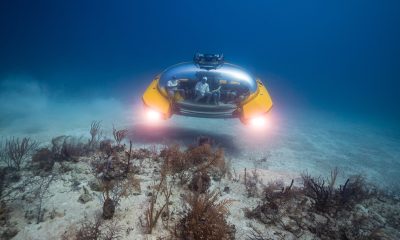Journal of passenger on 1st commercial cruise around world being auctioned off
One passenger went overboard - never to be seen again.
Published
2 years ago onBy
Talker NewsBy Lauren Beavis and Athena Stavrou via SWNS
A journal written by a passenger on the first commercial cruise around the world which was inspired by the adventures of Phileas Fogg is going on sale.

The SS Ceylon was the first yachting cruise ship in history that ventured around the world in 1881.
One of its passengers was Rev. William Alfred Essery who made a handwritten 280-page account of his trip, like Phileas Fogg.
The journal describes his adventures on board, as well as descriptions of the vessel and an account of one passenger who went overboard - never to be seen again.
Rev Essery's journey began when the cruise liner left Southampton harbor on 29 October 1881 and returned back on 22 August 1882.
It stopped in many countries around the world, such as India, China and the USA.

The ship belonged to friends and business partners James Culliford and John Lockie Clarke.
They established Culliford & Clarke in London in 1875 and were thought to have been inspired by Jules Verne’s book 'Around the World in Eighty Days.'
The handwritten book goes on sale with Dominic Winter Auctioneers on July 20 and is expected to sell for over $1,000.
The brochure states: ''An unpublished manuscript account of one of the earliest commercial pleasure cruises and the first commercial cruise around the world.
''The SS Ceylon was a single-screw, iron-hulled auxiliary steamer built by P&O in 1858 for use on the regular service from Southampton to Malta and Alexandria.
''With accommodation for 130 first and 30 second-class passengers it was bought by the fledgling Inter-Oceanic Yachting Company Ltd.
''The Company belonged to friends and business partners James Culliford and John Lockie Clarke who had established a steamer brokerage, Culliford & Clarke in London in 1875.
''No doubt partly inspired by Jules Verne’s Around the World in Eighty Days (1872) Clarke dreamt of going into leisure cruising and with some marketing fanfare they planned this ten-month voyage which was to take place from late October 1881 to late August 1882, covering some 37,500 nautical miles and stopping at various exotic and alluring places on the way.
''While this account inevitably describes a lot of day-to-day life on board the ship Essery was one of the few people that completed the whole journey and gives some interesting accounts of places visited.
''This manuscript is, therefore, a potentially unique and historically important account of this first commercial world cruise.''

The account is divided into chapters of various parts of his trip.
Chapter I. First days at sea – Bordeaux; II. Beautiful Lisbon and Belem; III. Jebel-al-Tarik; IV. Coasting in the Mediterranean; V. Crowded Naples & empty Pompeii; VI. Rounding Sicily to Valetta; VII.
From the Piraeus to the Golden Horn; VIII. Smyrna city, castle & missions; IX. The Island of Roses & the city of Alexander; X. Onward to India; XI. Seeing Bombay; XII. Ceylon’s isle; XIII. Twenty-four hours in Madras; XIV. British India’s capital; XV.
In the straits of Malacca; XVI. Sailing up China Sea; XVII. Hong Kong & Sunday in Canton; XVIII. Canton, doing the sights; XIX. From Hong Kong to Nagasaki; XX. Through five Nadas – Kioto; XXI. Missions in Kioto & Osaka – Yokohama; XXII.
Honolulu & Hilo; XXIII. Going to San Francisco and the equator; XXIV. On the South Pacific; XXV. Through Magellan Straits to Monte Video; XXVI. A trio of South Atlantic Ports; XXVII. Across the tropics, homeward.
The vessel, which had both a steam engine and sails, was built by P&O in 1858.
The ship's initial purpose was to provide regular service from Southampton to Malta and Alexandria.
Standing 305 feet long, 41 feet wide and weighing 2.1 gross register tons, the SS Ceylon was barely the size of the smallest cruise liners operating today.
She was purchased by English ship broker John Lockie Clarke in June 1881.
Clarke and his friend James Culliford both set up Inter-Oceanic Steam Yachting Company Limited (IOSYC) in the same year - the world’s first company determined to curate the world’s first designated cruise line.
Clarke had dreamt of going into the leisure cruising industry six years before – but the concept of such travel was still very much in its birth.
During the time, there were no cruise ships and those in the shipping industry were unsure of whether the phenomenon would ever take off, let alone make a profit.
Originally sized to accommodate 130 first-class passengers and 30 second-class passengers – the pair refit the ship to just sleep 100 first-class passengers in 49 cabins across two decks.
This was to allow more space for public areas, such as a dining room, an exclusive ladies' dressing room and a smoking room for the gentlemen.
Musical entertainment was also provided by the ship’s orchestra and a steam-powered fairground organ.
In his description of the ship in his journal, Mr. Essery highlights the impressive nature of the cruise liner.
He wrote: "She has a spacious main deck, large and perfectly ventilated saloon 8ft3inch in height and amply and well-arranged domestic offices, which stem her as a luxurious passenger steamer.
"Added to this, an elegantly appointed ladies boudoir and comfortable smoking and card room have been erected upon the upper deck.
"Every detail is being attended to with the view of promoting the convenience of the passenger and the pleasure of the voyage."
Within the journal, Rev Essery describes vast details of life on board the famous cruise line and his excursions off the ships to exotic destinations.
He also describes a tragic incident where a man went overboard never to be seen again.
His account reads: “The unhappy man had flung himself wildly from the fore part of the ship and must in a few moments have been beyond all human help.”
Dominic Winter Auctioneers report that no other published work of the whole voyage has ever been found - making this journal a particularly unique find.
Despite the incredible travel experience of a lifetime, the cruise did not make the cut to be classed as a commercial success.
This is because the cruise filled under half of its capacity – with only 40 guests actually paying to be onboard.
It appeared that the demand for long-haul journeys across the unknown oceans was not there, despite the impressive technological advancements of the period.
The lot also includes photos of Rev Essery and letters from himself the book's dedicatee Miss Anne H. Sutton.
The sale can be viewed here.
Stories and infographics by ‘Talker Research’ are available to download & ready to use. Stories and videos by ‘Talker News’ are managed by SWNS. To license content for editorial or commercial use and to see the full scope of SWNS content, please email [email protected] or submit an inquiry via our contact form.
You may like


Poodle trapped under a home rescued


This turtle can’t return home because of Brexit


Hedgehog deflated after swelling to twice its normal size


Campervan drives world record one million miles


Mini rope bridges built to help tiny creatures cross treetops safely


Man builds mouse village complete with tiny pub and book shop
Other Stories


Shop owner discovers Victorian jail cells hidden in her basement
She purchased the store having no idea about it history.


Scientists explain why there are ‘spiders’ on Mars
The creepy crawlies are actually small, dark features that form when this happens.


Doctor celebrates 2000th vasectomy with a sperm-themed cake
He says he hopes to raise awareness about the procedure.


Dog theft causes same emotional turmoil as losing a child: study
Some felt the loss was even more intense than the death of a friend or relative.


New innovative submarine looks just like a UFO
It has been specifically designed for the cruise and hospitality sectors.
Top Talkers

 Parenting1 week ago
Parenting1 week agoSingle mom details struggles of feeding her 12 kids

 Lifestyle7 days ago
Lifestyle7 days agoWoman regrets her tattoo nightmare: ‘It’s horrendous’

 Wildlife3 days ago
Wildlife3 days agoClever elephant returns visitor’s shoe that fell into enclosure

 Good News4 days ago
Good News4 days agoDisabled student takes first steps in 10 years on graduation stage

 Health4 days ago
Health4 days agoNew study reveals ‘old age’ begins later than it used to

 Broadcast1 week ago
Broadcast1 week agoHow hard is it for Americans to live sustainably?

 Environment1 week ago
Environment1 week agoHow hard is it for Americans to live sustainably?

 Work2 days ago
Work2 days agoHow much does your workspace affect productivity?
